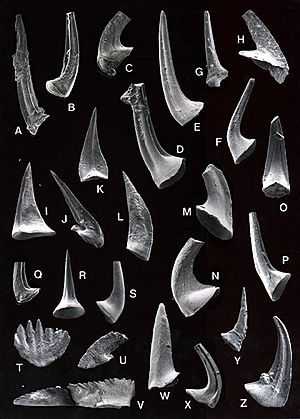Gasconade Formation facts for kids
Quick facts for kids Gasconade FormationStratigraphic range: Ordovician |
|
|---|---|

Conodonts from the Gasconade Formation
|
|
| Type | Formation |
| Sub-units | Basal Gunter Sandstone member |
| Underlies | Roubidoux Formation |
| Overlies | Eminence Formation Cambrian (unconformable) |
| Lithology | |
| Primary | Dolomite |
| Other | Sandstone |
| Location | |
| Coordinates | 38°12′N 91°06′W / 38.2°N 91.1°W |
| Region | Missouri |
| Country | |
The Gasconade Formation is a special layer of rock found in the Ozark Mountains of Missouri, USA. It's like a giant history book made of stone! This formation holds amazing clues about ancient life, especially fossils from a time called the Ordovician Period.
Contents
What is the Gasconade Formation?
A geologic formation is a unique layer of rock that geologists can identify. Think of it like a specific chapter in Earth's long story. The Gasconade Formation is mostly made of a rock called dolomite. Dolomite is similar to limestone, but it has more magnesium. It also contains some layers of sandstone.
Where is the Gasconade Formation Found?
This rock layer is mostly found in the beautiful Ozark Mountains region of Missouri. The Ozarks are known for their rolling hills, forests, and many caves. The Gasconade Formation is often found deep underground, but it can also be seen in places where rivers have cut through the land, like along the Gasconade River.
What Fossils are Inside the Gasconade Formation?
The Gasconade Formation is famous for the fossils it preserves. These fossils tell us about the creatures that lived in the oceans millions of years ago during the Ordovician Period. This was a time when life in the seas was really starting to boom!
Ancient Sea Creatures: Monoplacophora
One type of fossil found here is from creatures called Monoplacophora. These were small, cap-shaped sea snails. They had a single, simple shell, a bit like a tiny limpet. They lived on the seafloor and probably grazed on algae or other tiny bits of food.
- Kirengella
- K. expansus
- Titanoplina
- T. meramecensis
These specific types of Monoplacophora, like Kirengella expansus and Titanoplina meramecensis, help scientists understand what the ancient oceans were like and how life evolved over time. Finding these fossils in the Gasconade Formation helps us piece together Earth's ancient past.

